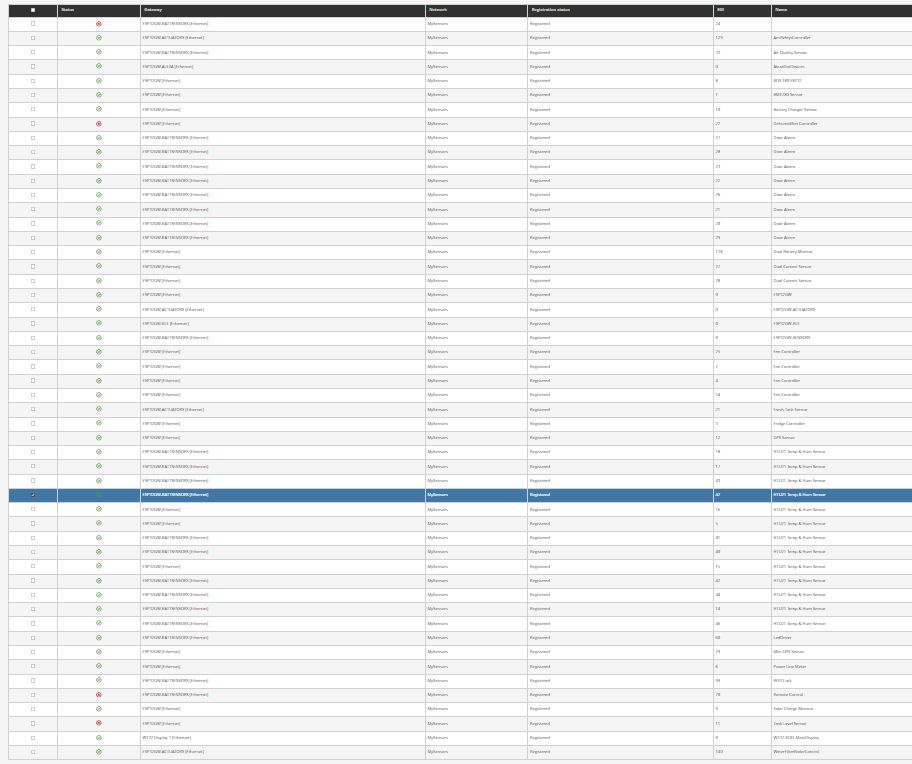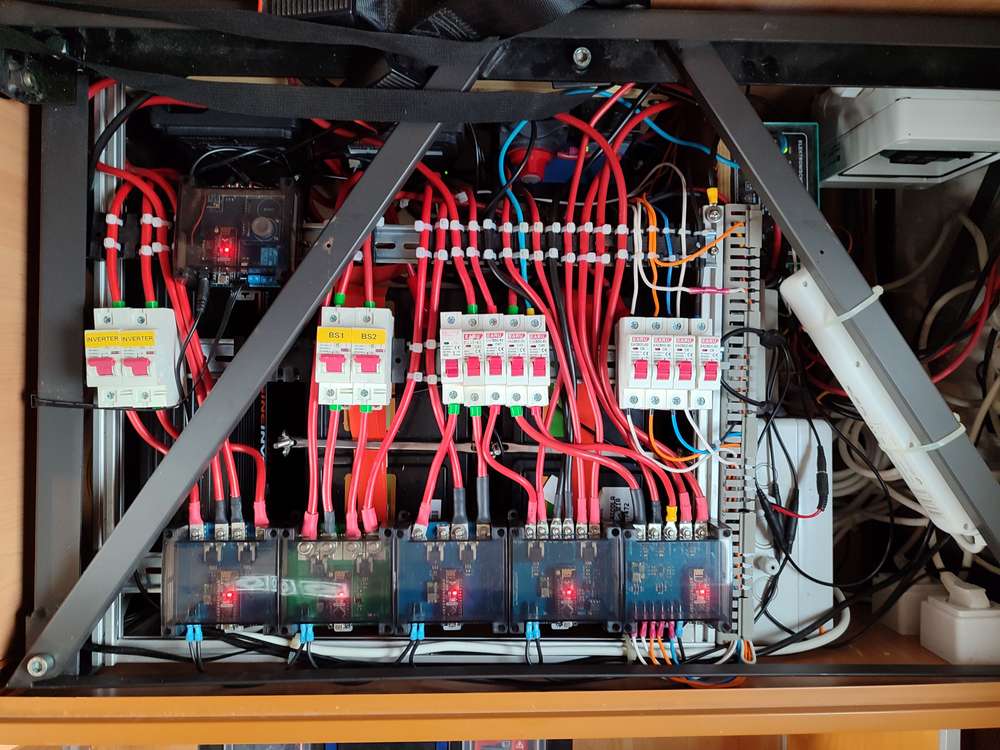@sebastieng too much load ? one 120ohm on the far one should be enough
fsgraz
Posts
-
RS485 transmit errors -
Getting Better Range with NRF24L01 Modules@sindrome73 in the gateway and the nodes you have a
#define MY_RF24_DATARATE RF24_250KBPS
The default value is RF24_1MBPS.
Just add the line above if it's not in your sketches
Both gateway and nodes must be set to the same speed.Buon divertimento!
-
Getting Better Range with NRF24L01 Moduleslower the speed, it makes a huge difference.
also, check the nRF24 power supply. -
Flame Sensor Not Triggering Setup@Jordan22xx do you mean via Serial Monitor from the pro mini ? if it works that would exclude hardware issues. do you poll the pin in the loop ? do you use an interrupt pin ?
I would exclude problems with the mysensors library. is the gateway recognized by the controller ? Check if the node is registered and the sensor presentation works. -
Some questions on how gateway works@mfalkvidd I got what you mean.
Yes, I am using the tcp connection using the mySensors serial API, not the USB<>UART serial interface ;-)I am running a gateway with the nRF24 at 1Mpbs for the fast & furious sensors (mainly energy meters); another at 250kbps for the battery supplied nodes (temp/hum and door sensors); another one at 1Mbps dedicated to the actuators / mission critical.
60 nodes runningAnother on is a BLE<>Mysensors bridge between the Mopeka Tank Pro (2) and the TPMS (4)
Another one is a fauxmo<>Mysensors bridge.A few esp32 based displays (round oled, 3.5", 7")
:-)
-
Some questions on how gateway works@mfalkvidd thanks.
I am happily running 6 esp32 WiFi gateways with nRF24L01+, but with the mysensors serial protocol, not mqtt. I don't see any value on MQTT for a local system based entirely on mysensors like mine, but I might be wrong and don't see the potential.
I have a couple of them working as bridges, like between BLE sensors and mysensors, or Alexa an mysensors, meteo RSS Feed etc.
-
Keen to build againIt depends a lot on what you can do. As @OldSurferDude wrote, if you want a cheap solution, this is the way to go. Also when you need something that is not available on the market. Here below the list of my camper nodes.
IMO mySensors is the best possible alternative, if not the only one, to the systems that rely on standards, which require way too many resources for the job they are asked.
In my case, several nodes have edge capabilities, because they have to keep working even if the controller is not responsive.

-
Code Garage to the rescue.it is up and running
-
Some questions on how gateway workslet me also add that if the serial protocol is possible with an ethernet gateway, I would prefer that, w/o messing with MQTT.
-
Some questions on how gateway worksMaybe is a silly point, but the node presents itself to the gateway, and afterwards you should see your node in your controller. The node ( in myController V1 that is my choice) I see the node's registration status as New. I need to edit the node properties and change the node status to Registered. After that the sensors show up.
there's also an inclusion mode in the gateway if this is not possible with Vera:
// Enable inclusion mode
//#define MY_INCLUSION_MODE_FEATURE// Enable Inclusion mode button on gateway
//#define MY_INCLUSION_BUTTON_FEATURE
// Set inclusion mode duration (in seconds)
//#define MY_INCLUSION_MODE_DURATION 60
// Digital pin used for inclusion mode button
//#define MY_INCLUSION_MODE_BUTTON_PIN D1 -
CHATGPT My new best friend!Fully agree with you about the library. The best one for sensors, amazingly stable and openly useable with lots of controllers.
And the combo ATmega328P + nRF24L01+ just great.
-
Code Garage to the rescue.@TheoL I wish nRF will be supported for longer time. Maybe just be free to specify the payload lenght instead ?
But I am with you on wishing for MySensors protocol over wifi with extendable lenght.
-
Status of my rv(camper) home automation system 2020-2025@OldSurferDude same here :grimacing:
-
Status of my rv(camper) home automation system 2020-2025@fsgraz I have also a system with temperature and humidity sensors at home, but I don't think I will improve that
-
Status of my rv(camper) home automation system 2020-2025@TheoL I use the nRF24L01+ because my use case is my RV, which is 6m long and 2m wide, so the radios are all working at the lowest power level
-
Status of my rv(camper) home automation system 2020-2025@TheoL thank you !
for me this excellent platform is all but dead.
I just ordered 10 nRF20L01+ and 10 SI24R1 modules in SMD form factor, just in case. -
Status of my rv(camper) home automation system 2020-2025I'd like to share with you the figures after 6 years of dedicated work to my system:
controller: #mycontroller v1
database: influxDB v.1.8
visualisation: grafana v.9.3.2
events and mobile UI: node-red
peer-to-peer VPN: ZeroTier One5 gateways
3 displays
52 nodes
392 sensors935 sensor data/minute
Hardware:
Beelink SLIM-T4PRO Windows 10 Pro
ESP32
Arduino Nano
Arduino RF-Nano
Arduino Mini
Radio nRF24L01+
Mobile router Teltonika RUT241 E-SIMThank you MySensors !
-
Why is the output of ACS712 current measurement module unchanged?@ZenBlizzard in case you are measuring the output with a multimeter, you will get an averaged level, since AC current waveform should be sinusoidal and overlapped with the Vcc/2->2.56V in your case.
To measure the current you need a decently high sampling and some math.#define SENSITIVITY 66 // mV/A const float readings = 5; const float alpha = 2.0 / (2 * readings + 1); for (ifor = 0; ifor < 250; ifor++) { // Voltage voltageSampleRead = analogRead(V) * vccRead / 1023 - vccRead / 2; /* read the sample value including offset value*/ voltageSampleSum = voltageSampleSum + sq(voltageSampleRead); /* accumulate total analog values for each sample readings*/ voltageSampleOffsetSum = voltageSampleOffsetSum + voltageSampleRead; // Current currentSampleRead = analogRead(I) * vccRead / 1023 - vccRead / 2; /* read the sample value including offset value*/ currentSampleSum = currentSampleSum + currentSampleRead * currentSampleRead; /* accumulate total analog values for each sample readings*/ currentSampleOffsetSum = currentSampleOffsetSum + currentSampleRead; wait(1); } voltageMean = voltageSampleSum / ifor; /* calculate average value of all sample readings taken*/ voltageOffset = voltageSampleOffsetSum / ifor; reading = (sqrt(voltageMean) - voltageOffset) * 230.0 / 1.0; // read voltage / reported voltage. voltage = round_to_dp(alpha * reading + (1 - alpha) * voltage,1); Serial.println(voltage); if (voltage < 25) voltage = 0; currentMean = currentSampleSum / ifor; /* calculate average value of all sample readings taken*/ currentOffset = currentSampleOffsetSum / ifor; reading = (sqrt(currentMean) - currentOffset) / SENSITIVITY * 1000 - currentZeroOffset; // subtract no load current. if (reading < 0) reading = 0; current = round_to_dp( alpha * reading + (1 - alpha) * current,2); -
Sensor to detect marijuana vape/smoke@Hellmark I have a sensor with a dust sensor, and it detects sigarette smoke pretty well.
I use it in my RV and act on the fairing vents. -
A low cost energy meter@OldSurferDude yes, you are correct. this sensor is capable of 50A continuous, which safely I would make it working at 40A max., but for such an important load as in your case I would go for a beefier one, like the ACS75x, 77x, but at this point I would also change the node's form factor for space and insulation reasons.
On my application on the RV I have a max. curr. of 13A running on a AWG14-16 cable (European rules for RVs), so I did not ask myself too many questions beside, of course, safety.
About the signal, it will be a sinusoidal signal swinging around Vcc/2.
Vcc can be easily measured internally on the ATmega328. On all my DC sensors I measure Vcc at every loop, just before measuring the ADCs.Honestly, when the space is not an issue like in my RV, I would rather use a ring core current transformer, and I would get rid of noise, response time, power dissipation, but over all no need to cut any cable.
Long story short, it has been a nice experiment and I used it for 6 months, and then I switched back to my RF-NANO based RS485-Modbus - Mysensors bridge connected to an off-the shelf power analyzer.
Just for fun I attach a pic of my 12Vdc sensors installed on my RV. Forgive me for the spaghetti wiring on the right side, but this is an area that needs improvement.

